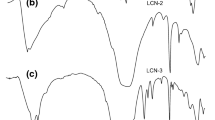Abstract
Microwave synthesis method was applied to the fast preparation of LiCoO2. The structure of the synthesized oxides was analyzed by using X-ray diffraction. Only single-phase LiCoO2 was obtained. Electrochemical behaviors of LiCoO2 were investigated by charge-discharge cycling properties in the voltage range of 3.00 – 4.35 V (vs Li). The results show that the prepared LiCoO2 powders calcinated at 900 °C for 120 min exhibit an initial charge and discharge capacity of 168 and 162 mA · h · g−1 at 0.1C current rate, respectively, as compared to 159 and 154 mA · h · g−1 of LiCoO2 synthesized by conventional means. In addition, more than 95% of the capacity is retained even after 10 cycles. But with the increase of calcinating time, its electrochemical properties deteriorate. Compared with the conventional method, the microwave heating method is simple, fast, and with high energy efficiency.
Similar content being viewed by others
References
Yoshio N. Lithium ion secondary batteries: past 10 years and the future [J]. J Power Sources, 2001, 100 (12):101–106.
Gopukuma S, Yonghyun J, Wang K. Synthesis and electrochemical performance of tetravalent doped LiCoO2 in lithium rechargeable cells [J]. Solid State Ionics, 2003, 159: 223–232.
Larcher D. Electrochemically active LiCoO2 and LiNiO2 made by cationic exchange under hydrothermal conditions [J]. J Electrochem Soc, 1997, 144 (2): 408–417.
Yazami R. High performance LiCoO2 positive electrode material[J]. J Power Sources, 1995, 54(2):389–392.
Yan H W, Huang X J, Lu Z H, et al. Microwave synthesis of LiCoO2 cathode materials [J]. J Power Sources, 1997, 68(2): 530–532.
Houmes J D. Microwave synthesis of ternary nitride materials [J]. Journal of Solid State Chemistry, 1997, 130(2): 266–271.
Kiddle J J. Microwave irradiation in organophosphorus chemistry (Part 2): synthesis of phosphonium salts [J]. Tetrahedron Letters, 2000, 41(9): 1 339–1 341.
Lee M J, Sun C M. Traceless synthesis of hydration by focused microwave irradiation [J]. Tetrahedron Letters, 2004, 45(2): 437–440.
Oliver K C. High-speed combinatorial synthesis utilizing microwave irradiation [J]. Current Opinion in Chemical Biology, 2002, 6(3): 314–320.
SU Mian-zeng. Solid State Chemistry: An Introduction [M]. Beijing: Peking University Press, 1987. (in Chinese)
Bhat M H, Chakravarthy B P, Ramkrishnan P A, et al. Microwave synthesis of electrode materials for lithium batteries [J]. Bull Mater Sci, 2000, 63(6): 461–466.
Teoreanu I, Andronescu E. Microwave processing of Ba2Ti9O20 ceramic [J]. Ceramics International, 1996, 22(4): 305–307.
LIU Jing, WEN Zhao-yin, WU Mei-mei, et al. Synthesis by a complexation route and characterization of LiCoO2 cathode materials [J]. Journal of Inorganic Materials, 2002, 17(6): 1 157–1 161.
YAN Hong-wei, HUANG Xue-jie, CHEN Li-quan. Microwave synthesis of LiMn2O4 cathode materials [J]. J Power Sources, 1999, 81–82(12): 637–650.
HUANG Ke-long, XIONG Qi. Structure and electrochemical properties of metal type LiCoO2 [J]. Dianchi, 2001, 31(6): 264–267. (in Chinese)
Author information
Authors and Affiliations
Corresponding author
Rights and permissions
About this article
Cite this article
Hu, Gr., Liao, G., Peng, Zd. et al. Structure and electrochemical properties of LiCoO2 synthesized by microwave heating. J Cent. South Univ. Technol. 11, 261–264 (2004). https://doi.org/10.1007/s11771-004-0053-y
Received:
Accepted:
Issue Date:
DOI: https://doi.org/10.1007/s11771-004-0053-y




